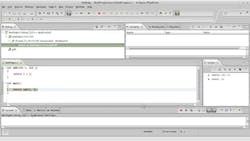The Best of 2015 Electronic Design choice for software is often a challenge because of improvements, but this year one stands out.
“It failed, but how did I get here?” This is a typical lament of a developer using a debugger when a program fails. Usually a breakpoint can be set after the fact or well before, but pinpointing where and how a failure occurs is often as much art as it is skill. That was until Undo Software developed UndoDB, a reverse-execution debugging tool. Undo Software’s UndoDB is a trace-based debugging tool that allows replaying of execution and data for almost any application in using debug platforms like the Eclipse IDE (see the figure).
UndoDB essentially instruments an application, allowing it to trace the execution of the program. This log is stored and then replayed by the enhanced debugger that knows about the UndoDB log file. It can step forward or backward. This is similar to many trace/debug facilities that can move backwards and forward through the execution list.
The difference is that UndoDB tracks data operations as well and can present the contents of registers and memory values. This means it can also scan and set breakpoints associated with data. For example, if the program stops when a bad value is detected it is possible to backtrack to determine when the value was changed and even examine other values that might have been used to compute the bad value.
The typical overhead for using UndoDB is about 1.7. The system can handle multicore systems that use shared memory. It can also handle multiple threads.
Finding bugs can be a difficult task, but UndoDB can greatly reduce the time to find the root cause of an application.
About the Author
William G. Wong
Senior Content Director - Electronic Design and Microwaves & RF
I am Editor of Electronic Design focusing on embedded, software, and systems. As Senior Content Director, I also manage Microwaves & RF and I work with a great team of editors to provide engineers, programmers, developers and technical managers with interesting and useful articles and videos on a regular basis. Check out our free newsletters to see the latest content.
You can send press releases for new products for possible coverage on the website. I am also interested in receiving contributed articles for publishing on our website. Use our template and send to me along with a signed release form.
Check out my blog, AltEmbedded on Electronic Design, as well as his latest articles on this site that are listed below.
You can visit my social media via these links:
- AltEmbedded on Electronic Design
- Bill Wong on Facebook
- @AltEmbedded on Twitter
- Bill Wong on LinkedIn
I earned a Bachelor of Electrical Engineering at the Georgia Institute of Technology and a Masters in Computer Science from Rutgers University. I still do a bit of programming using everything from C and C++ to Rust and Ada/SPARK. I do a bit of PHP programming for Drupal websites. I have posted a few Drupal modules.
I still get a hand on software and electronic hardware. Some of this can be found on our Kit Close-Up video series. You can also see me on many of our TechXchange Talk videos. I am interested in a range of projects from robotics to artificial intelligence.

